Twitter released the ability to tweet simple polls in late October last year, and since then, marketers have been experimenting with a bunch of different ways to use them. They’re making it easier than ever to harvest data from your followers, in a way you can control. Gone are the days of tallying hashtags or counting likes; polls are changing the game.
How Polls Work
Everyone on Twitter has access to the ability to make polls. It’s right there at the bottom of the compose tweet box; the Poll option, or the pie chart looking button at the bottom of the mobile app compose box. Click or tap it, and you’re presented with the poll box.
By default, the poll only begins with two choices. Obviously, to make a valid poll, you need at least two options to pick between. You can click or tap to add options, up to a total of four. Sorry, people who want to offer five options; you’ll have to find another way of doing it.
The default poll runs for a total of 24 hours, after which it closes to new input. You can change this, however, and run the poll for up to 7 days. You can even specify how long it runs down to the minute, by choosing day – hour – minute in the drop down boxes. You can also, of course, choose to remove the poll if you don’t want to make one after all.
Polls interact in an interesting way with Twitter’s character limits. When you start to compose a tweet, as we all know, you have 140 characters in which to do it. When you click to add a poll, even if you haven’t put a single letter in the compose box first, your character count drops to 116. A poll, then, counts for 24 characters worth of a tweet.
Adding options does not decrease your character count, and the length of each option does not matter as far as the tweet itself is concerned. You can have four 1-letter options or two max-character options and it still leaves you 116 characters for your question.
Each option is limited to just 20 characters, however, so make sure you’re concise with your options. This shouldn’t be a problem, really; you’re using to being concise with Twitter one way or the other.
Users are able to see the number of votes in a poll, and the time remaining, but they can’t see the results until they have voted or the poll is over. You, meanwhile, can see the results but cannot vote in your own poll. You also can’t edit the poll once it’s in motion, you can only choose to delete the tweet to remove it.
Voting in a poll is not a direct form of engagement, in that it cannot really be interacted with itself. You cannot see who amongst your audience voted for an option, and nothing shows for that user when they vote in the poll. It doesn’t appear in their feed. Voting alone does not share a poll; it acts just like any other tweet and must be retweeted or replied to for further exposure.
Thankfully, Twitter is smart enough to avoid fragmenting poll results when your poll is retweeted. Any votes on a retweet of your poll are applied to the primary poll.
You cannot retweet your own poll. As such, it’s highly recommended that you pin the poll to the top of your feed, and then promote it occasionally with other tweets, possibly linking to the poll URL itself.
Surprisingly enough, while you would think polls would be flooding Twitter, they’re surprisingly sparse. I don’t know if there was a flood that died down or if they’re just not that popular to begin with.
Oh, and one more thing; you can’t attach an image, gif, or vine to a poll. They’re mutually exclusive variants of the tweet format. If you click to add a poll, the “media” button fades out, and if you click to add media, the poll button fades.
So, how can you use Twitter polls to boost engagement and interaction with your Twitter account? Well, the simple answer is just use them. Read on, though, for more specific techniques.
Drum Up Gentle Controversy
This is one technique you often see on Facebook and Twitter already, and polls make it that much easier. The idea is to ask a simple question that gets people debating in the comments, because comments are good. This is more important on Facebook, where repeated comments increase your EdgeRank, and correspondingly help your posts reach more people. It’s good on Twitter too, though, simply because it generates a flow of retweets and replies that shares your content around, and gives you fodder to retweet yourself.
The number one rule is to be very cautious with the kind of controversy you stir up. You want to avoid topics like religion, gun control, healthcare, or racism; you stir up angry feelings and get people to react negatively to your brand.
The controversy you want to use is simple, gentle controversy. Things like “cake vs. pie” or “who should win tonight’s football game?” One of the examples Twitter themselves used when they debuted polls was commentary on a ref call in a sports game of some type.
Just remember; anything you post on Twitter is there to stay. You can delete tweets, but the vast majority of the time, someone will be able to dredge up your old posts and throw them back at you. You only have one chance to get things right, and if you screw up, the negative brand reputation sticks with you for months or years.
Vote for Future Content Options
“We’re producing a new ebook! Should it be about Facebook marketing, or Twitter marketing?”
This is the kind of simple question you can ask to both drum up interest and gauge which option you should pursue. Some people will want one option, others will want the other. Some people will ask you why not both?
You can do this with ebooks, with blog posts, or even with infographics and other less central content. You can also do it with product features or bug fixes you want to prioritize, or future deals. “Would you prefer a 10% discount or a BOGO on orders under $10?” Come up with two comparable offers and ask which one is better.
If you want, you can tie this into a contest as well. Require that a certain option gets X number of votes to be put into effect, so people have to work together to get the deal they want, as well as spread it around for more exposure and engagement.
The best part of this method is that it gets people to weigh in on the option they would prefer to see, which helps you judge how accurate your grasp of your audience is. If you figure that one option should win by 70% but it doesn’t, you may have to readjust your customer personas or your analytics.
Of course, in almost every case, this will just be a poll about priority. As long as the second option receives any votes at all, it’s still worth creating for those people who are interested in it.
Predict Future Outcomes
Who is going to win the next presidential election? Do you think the next Powerball drawing will have a winner? How much money will the new Star Wars film make on opening night?
You can ask simple questions like these in an attempt to get your audience to predict the future. It has a bit of the controversy element to it, but it tends to be more vague and light hearted than an actual controversy.
This works best when you’re marketing for an entity that has a stake in the competition being presented. For example, something like Dancing With the Stars or American Idol can host Twitter polls about who will win a competition or a season. Of course, you don’t have a lot of space to work with; with only four options, you can’t exactly list a whole pool of contestants and ask the audience to pick their favorite. You have to wait for 1v1 or small team competitions where you can list team names, or otherwise fit all of the options into four choices.
Reference Pop Culture for Humor
There’s always room for a good reference to pop culture, be it music, television, or a best selling book. What’s the #1 most played song? Reference a lyric and make a poll out of it.
“#StarWars When the alarm goes off in the morning, the Force:
– Awakens
– Hits snooze”
It’s not really relevant to anything with your business, but who cares? Eight out of ten tweets you make shouldn’t be directly related to your business anyways. Most of them will be industry-related comments, questions, or retweets, sure, but there’s no reason you can’t occasionally make a reference to something popular in the world at large. It helps humanize your brand.
Jokes, puns, pop culture references, polls with strange options; it’s all relevant and viable if you can get it to work. Just don’t try to flood your Twitter feed with goofy polls; that’s one way to over-stay your welcome. It should always be something that can be appreciated by your audience as a whole. If you’re a B2B business with a lot of stodgy, corporate users, they might not appreciate a good pop culture reference, so it will fall flat. Don’t try to push it if that happens, just move on and try something else.
Solicit Product Feedback
The first step to improving your products is figuring out where their flaws are. You can’t do that if you don’t get any feedback from your users. Of course, feedback can often feel like pulling teeth. How often have you heard “it just doesn’t work!” People in general are pretty bad at giving specific causes to their frustration. They don’t want to think about it, they just want you to fix it.
You can solicit some feedback from your Twitter users in bite-sized chunks, if you formulate your questions effectively. For example, say you have a relatively new feature, or an older feature you’re considering removing. Ask your users if they use the feature frequently, infrequently, or not at all. Use the scale of the responses to determine how much emphasis to put on keeping or removing it.
The key here is to make sure you follow up, both on Twitter immediately and through your support over time. Otherwise, people will feel as though you’re asking their opinion and then nothing comes of it. That means they’ll be less inclined to give you any future feedback, because it “won’t matter” in the long run.
Livetweet Current Events
Responding to events in real time is one of the things Twitter is best at. That’s why news and politics is covered so well, and why trends are so powerful. It’s also why Twitter newsjacking is so potentially potent, both in a positive and a negative way. When you cover a trending topic, a newsworthy topic, you’re putting yourself at the center of any potential controversy and developments. You’re putting your stance and opinion on record, and dealing with the consequences.
In some situations, you can take advantage of this. The ref call I mentioned above, with the sports scenario, is one such option. You can run that poll for 30 minutes if you want, it’s just there for some short term engagement. Another example might be the current lead-filled water in Flint situation; run a poll asking if Governor Snyder should be prosecuted, let it run for a week, and reap in the discussion that takes place in the replies.
That situation does tend to run dangerously close to the kind of controversy you don’t want to touch as a brand, so keep careful to make your own opinions as far on the “correct” side of the issue as you can without looking like you’re just kicking the hornet’s nest.
Gather Market Research
Market research is generally not all that difficult to get. You have a lot of methods open to you. You can run large polls and surveys with Google Forms or Survey Monkey on your website. You can read analytics. You can ask for specific information from your opt-in forms. There will always be some gaps, however, so you can use Twitter to fill them in.
Typically, you’ll want to ask for information you can’t easily get in another way. Buffer asked its users once how often they tweeted, 6+ times per day or less. With the ability to add up to 4 options, you can expand this to more finely tuned information as well.
You can use this in two ways. The first way is to do a quick poll to see what sort of prevailing opinions or usage statistics hold true out there. The other is to ask for a piece of information that can verify a hypothesis you have going on. One piece of simple verification can tell you whether or not it’s safe to go ahead with a campaign or product improvement, without spending a lot of time or energy with more detailed market research.
Embed Polls in Blog Posts
Any and every one of the options above can be added to a blog post. All you have to do is embed the specific tweet, just like you would embed any other tweet. You can use open polls on your blog to promote answers with audiences who aren’t normally following your Twitter or who may have missed the post the first time around. You can then use closed polls as citations for information you use in other ways, like in analytical blog posts or in infographics.
In this case, your blog acts as an amplifier for your Twitter content, and can result in more comments on your blog posts and more responses to your tweet. It’s a win all around.

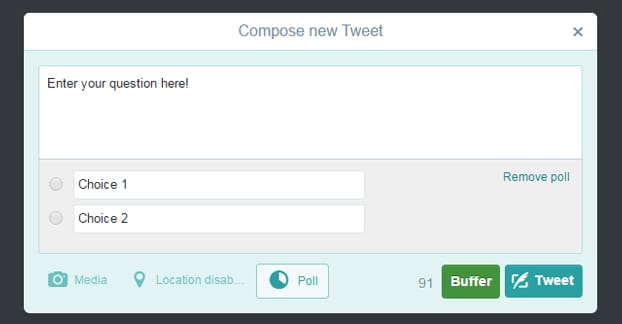
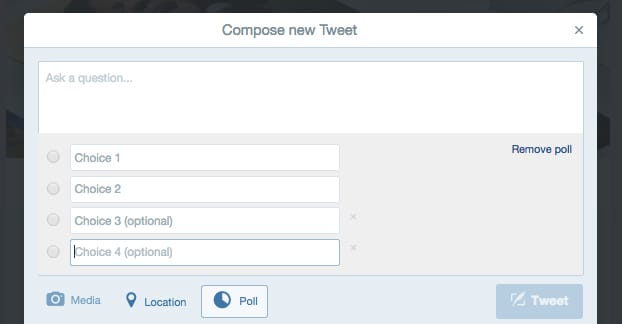

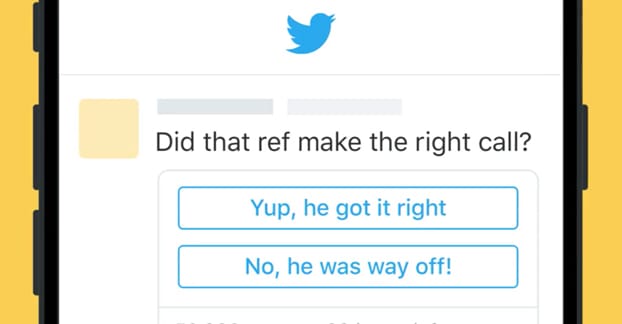

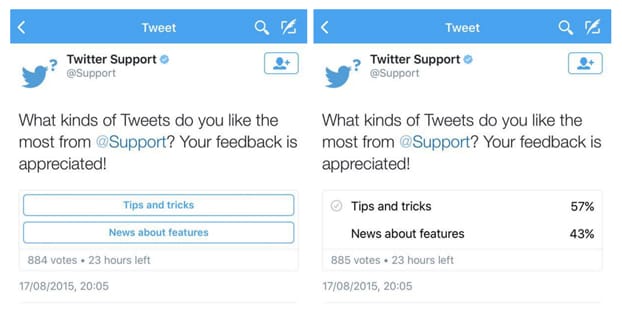

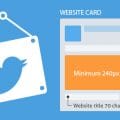


I created a poll a few days ago. Now, where can I view the results? I am amazed that I cannot find the answer to this simple question.